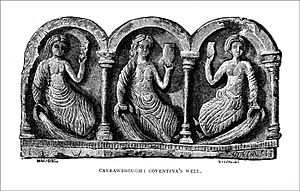Coventina facts for kids
Coventina was a special goddess from Roman Britain. People believed she looked after wells and springs. We know about her from many stone carvings found in one place in Northumberland, England. This spot is near a spring close to Carrawburgh on Hadrian's Wall. Some people think other old writings from Spain and France might also be about Coventina, but this is not certain.
Coventina's Amazing Well
People left gifts for Coventina in a special area built around a spring, which we now call "Coventina's Well." This well and its walled area are near an old Roman fort and town on Hadrian's Wall. The Romans called this place "Brocolitia" or "Procolitia." Close by, you can also find the remains of a Roman temple for the god Mithras and a shrine for water nymphs.
The well itself was a spring flowing into a rectangular pool. This pool was inside a larger walled area. When archaeologists explored the well, they found many interesting things! They discovered over 13,000 coins, from very old Roman times up to later periods. They also found a stone carving of three water nymphs, a man's statue head, and two special stone slabs dedicated to Coventina. There were ten altars (special tables for offerings) dedicated to Coventina and another goddess named Minerva. Plus, they found clay burners for incense and many other gifts left by people.
A British archaeologist named John Clayton dug up this site in 1876. We don't know exactly when the wall around Coventina's Well was built. Some experts think it was made after the Roman fort was finished, around 128 to 133 AD. Since Hadrian's Wall didn't go around the well, it might mean the well's wall was added later to help control water in a marshy area.
Evidence from the coins and stones covering them suggests that people stopped using the well around 388 AD. This might have happened because of big changes in beliefs at that time.
Statues of the Goddess
When the site was dug up, several carved altars were found. Some of these showed Coventina in a typical Roman style for a water nymph. She was shown lying down, partly clothed, and linked to water. On one carving, Coventina appears three times, or perhaps she is with two helpers.
Messages on Stone
At least ten stone carvings dedicated to Coventina have been found at Carrawburgh. Several stone altars had messages for Coventina, as did two pottery incense burners.
Here is an example of a message found at the site:
- Deae Cov{v}entinae /
- T D Cosconia /
- nvs Pr Coh /
- I Bat L M
This means: "To the Goddess Coventina, Titus D[unclear] Cosconianus, the leader of the First Group of Batavians, freely and deservedly dedicated this stone."
Three altars dedicated to the god Mithras were also placed there by military leaders.




